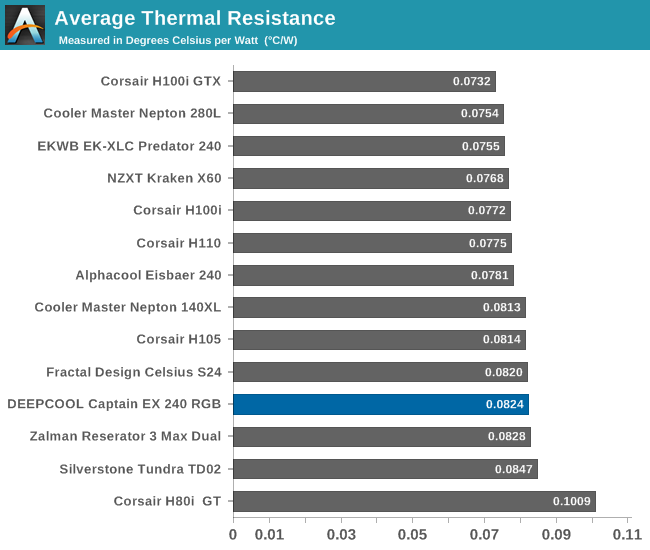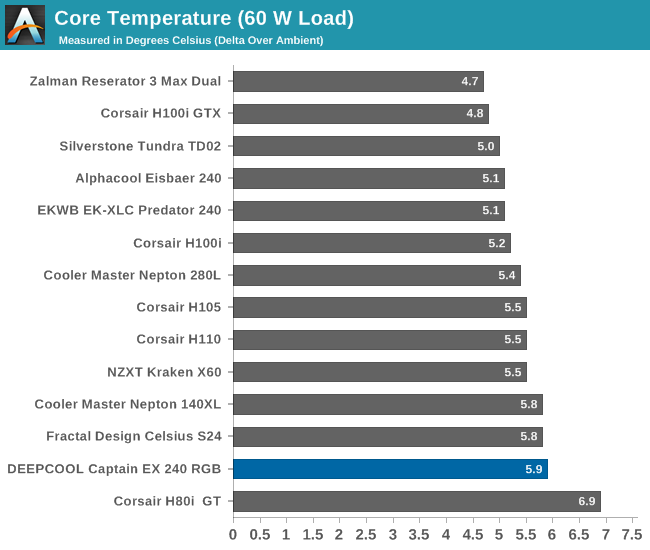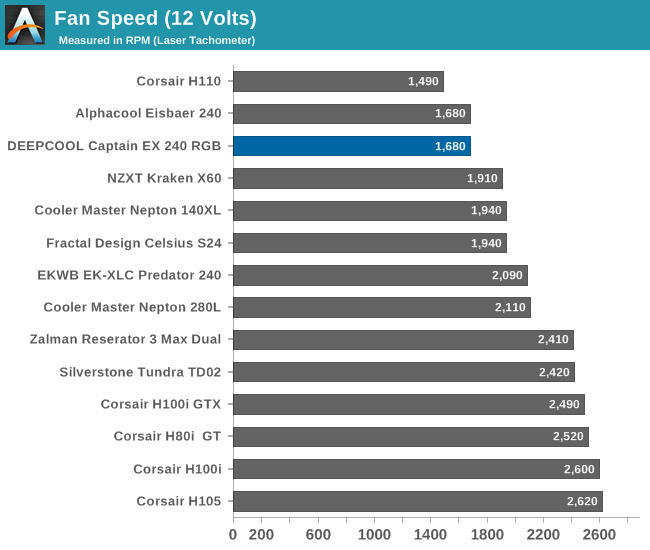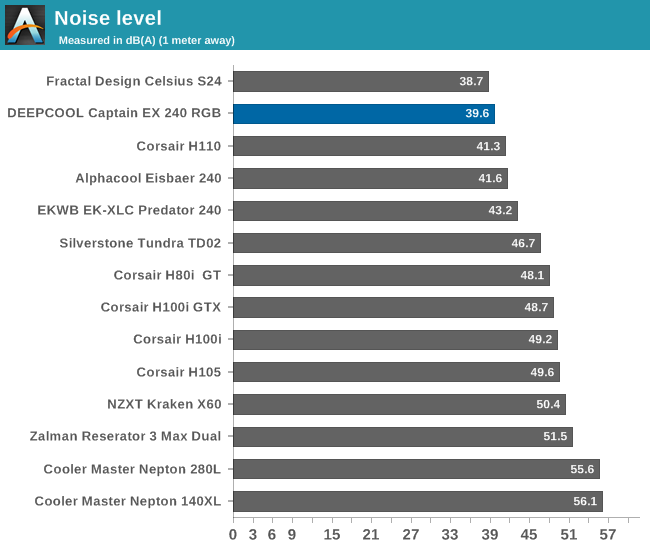The DeepCool Captain 240 EX RGB AIO Cooler Review: Pump it Up, Without the Noise
by E. Fylladitakis on December 14, 2017 9:00 AM EST- Posted in
- Cases/Cooling/PSUs
- AIO
- Deepcool
- Cooler
Testing Results, Maximum Fan Speed
Our maximum speed testing is performed with both the fans and the pump of the kit powered via a 12V DC source. At this voltage, the speed of the pump and the fans should match the manufacturer’s ratings. DEEPCOOL specifies that the TF120 fans have a maximum speed of 1800±10% RPM. Our tachometer indicated a speed of 1680 RPM, which is a bit on the low side but still fully inside the manufacturer’s specifications.

Our testing of the DEEPCOOL Captain EX 240 RGB was unsurprising, with the cooler’s thermal performance being very similar to that of most other equally sized AIO coolers. With the fans running at their maximum speed, the Captain EX 240 RGB has an average thermal resistance of 0.0824 °C/W, placing it higher than most dual 120 mm fan coolers. The average thermal performance of the Captain EX 240 RGB falls right in between the Zalman Reserator 3 Max Dual and the Fractal Design Celsius S24.

| Core Temperature, Constant Thermal Load (Max Fan Speed) |
Although the Captain EX 240 RGB does not land on top of our thermal performance charts, the acoustics performance of the cooler tells an entirely different story. Apparently, DEEPCOOL’s unique fans were not really meant to improve the thermal performance of the cooler but to significantly reduce its noise output instead. The maximum noise output of the Captain EX 240 RGB was 39.6 dB(A), which is second only to that of the Fractal Design Celsius S24.












34 Comments
View All Comments
Yuriman - Thursday, December 14, 2017 - link
It would be nice to see some common heatsinks within the same price bracket included in the comparison charts, even if it's only a handful. They're direct competition after all.HollyDOL - Thursday, December 14, 2017 - link
I have to agree, otherwise the results are quite relative.Put in at least a couple for reference (like Intel highend stock, AMD highend stock, and some elite one like Noctua NH-D15), it would make the info much more worthwhile for general public
HollyDOL - Thursday, December 14, 2017 - link
not like stock coolers could hope to do anything except bbq with 340W load ofc...Dr. Swag - Thursday, December 14, 2017 - link
Awesome! A decent alternative to the S24 when it comes to quiet AIOs that also has rgb!sweetca - Thursday, December 14, 2017 - link
Catchy name.Lord of the Bored - Saturday, December 16, 2017 - link
"I am Captain DeepCool, of the Federation starship EX RGB."ReeZun - Thursday, December 14, 2017 - link
Sometimes I wonder... if some of these reviews are sponsored (either by one manufacturer or a group of manufacturers, to boost brand exposure and potentially sales)... and not necessarily direct monetary sponsorship. I also wonder... if the reason Anandtech didn't include a high-end air cooler (e.g., NH-D15)... is because it would make a strong case for the AIO solutions making a very poor value proposition... especially when considering noise/cooling ratios... and, in turn, rendering this entire review pointless.E.Fyll - Thursday, December 14, 2017 - link
Actually, the answer to your question is far less complicated than that. We only compare air coolers to air coolers and liquid coolers to liquid coolers because each represents a specific type of product. It's an "apples to apples" kind of thing. I also personally do not believe that these two actually compete with each other. Users are much more likely to go for an AIO cooler because they want easier access to their system, or because they just don't like a 2kg piece of metal hanging off their motherboard, or just because it "looks cool", than for the performance. If acceptable performance is all that a user needs, an average air cooler can do the job just fine, they do not even need a NH-D15 to begin with.Besides that, the magic of having and using professional equipment like ours is that everything is both repetitive and comparable. They were all tested on the exact same device and everything is in our methodology page that can be found in every cooler review. Long story short, you can easily go to our review of the NH-D15 cooler (or any cooler that you'd like to compare, regardless of its type and platform) and just compare any of its performance figures to any AIO cooler that you want to, taking into account your personal requirements too.
tricomp - Thursday, December 14, 2017 - link
Sorry no.. it is green apples to red apples in most buyers considerations.. or dreams, and they really need to know what they are paying extra in case their dream comes true.rtfmx9 - Thursday, December 14, 2017 - link
I think that "apples to apples" does not hold here. After all, both liquid and air coolers serve the same purpose. It would be nice to be able to compare them without having to do research through Anandtech's archives. Is it possible that once comparison is made obvious liquid coolers don't make sense from the cost/performance point of view? I don't know since review does not try to inform me from that perspective. My guess is that there are many people who would like to inform themselves of whether upgrade to a liquid cooler would make sense or not but to do that you recommend that they dig though the past reviews instead of you offering that information in your review. All for the sake of keeping apples and oranges separated. I don't buy that reasoning.